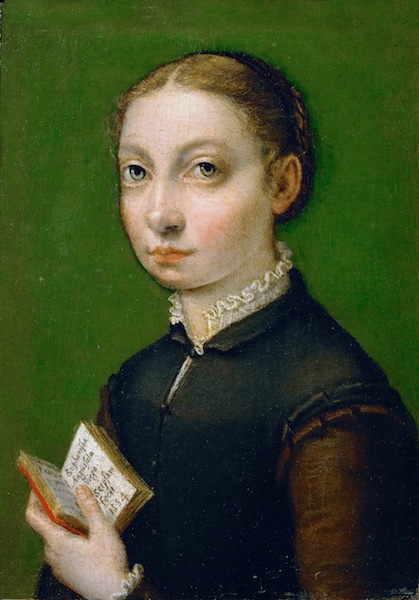 |
| Alexander Roslin Portrait of Anne Vallayer-Coster, 1783 |
Still life was not the most prestigious art form, but a nice picture of fruit or table-top objects enhanced a refined home, so there was a steady market for it.
The work for which she was most admired was highly polished flower paintings, bouquets of meticulously rendered blossoms, often in lavish vases.
Background: Anne Vallayer was one of 4 daughters born into an artistic family; her mother painted miniatures and her father was a master goldsmith who worked at the Gobelins company, which produced luxury objects, including the finest tapestry. During Anne's childhood, the family lived on the grounds of the factory.
When Anne was in her teens, the family moved to a more fashionable part of Paris; her father began to trade in jewelry and soon won royal patronage. His elevated status and aristocratic patronage may have helped her overcome some of the restraints that hindered many women artists.
Training: Anne became interested in sketching and painting at an early age and her mother encouraged her by arranging for her to have private tuition from a lady art teacher. She later trained with celebrated marine painter Joseph Vernet.
Career: In 1770, when Anne was 26, her tutors and fellow artists suggested that she apply to become a member of the Royal Academy. To gain admittance, she submitted two reception pieces, entitled The Attributes of Painting, Sculpture, and architecture, and The Attributes of Music. Anne's work was highly admired, and she was unanimously elected to the Academy. Anne was one of four women admitted that year, the Academy's previously set limit; they were among the first women to become members, an essential step toward a successful career.
In those days, the Academy admitted artists by category, with history at the top of the heap, and still life at the bottom. Anne was accepted as a painter of still lifes—which meant subjects like baskets of fruit and arrangements of dead game. Anne's work derives from that of Jean Chardin, France's most advanced still life painter, and Chardin, himself, was among the judges when she first applied to the Academy. Her acceptance meant that she was permitted to exhibit at the Academy's Salon exhibitions, which she did regularly until 1817, a total of 46 years.
After she entered the Academy, Anne's popularity expanded rapidly. In addition to still life paintings, she also did portrait commissions.
Anne exhibited her first floral still life paintings in 1775; they were evidently popular, as she tended to specialize in them after that. Some of these designs formed the basis of luxury tapestries.
Anne's popularity with members of the royal court brought her to the attention of Queen Marie Antionette, who became her patron and friend. In 1779, when Anne was 35, Anne was named Painter to the Queen, which entitled her to free lodging at the Louvre.
In 1781, Anne married a wealthy and well-connected lawyer named Pierre Coster. The marriage took place at Versailles, and Queen Marie Antoinette witnessed the marriage contract.
Anne continued to produce portraits, in addition to still life, until 1785, when her figurative work received scathing reviews from critics, who favored the portraits of Élisabeth Vigée-Lebrun and Adelaide Labille-Guiard. After that, Anne decided to quit competing for portrait work, and concentrate on still life, in which she was superior to her competitors.
Despite her connection to the throne, Anne was able to survive the French Revolution of 1789. She and Pierre moved to the countryside, and her career went into decline. Nevertheless, she continued to make flower paintings, and when the monarchy was restored, she was patronized by Empress Josephine.
My photos of Anne's work:
 |
| Attributes of Painting, Sculpture, and Architecture, 1769 Louvre Jan's photo, 2015 |
 |
| Still Life with Plums and a Lemon, 1778 Legion of Honor Jan's photo, 2017 |
Internet examples:
 |
| Still-Life with Tuft of Marine Plants, Shells and Corals, 1769 Louvre / Internet |
 |
| The Attributes of Music, 1770 Internet |
 |
| Portrait of a Woman with Violin, 1773 National Museum, Sweden / Internet |
 |
| A still life of mackerel, glassware, a loaf of bread and lemon, 1774 Internet |
 |
| Joseph-Charles Roettiers, 1777 Chateau de Versailles / Internet |
 |
| Vase of Flowers and Conch Shell, 1780 Metropolitan / Internet |
 |
| Garden Still Life, 1780 Basildon Park, Britain / Internet |
 |
| Still Life with Lobster, 1781 Toledo / Internet |
 |
| Madame de Saint-Huberty in the Role of Dido, 1785 NMWA / Internet |
 |
| Portrait of an Elderly Woman and her Daughter, undated Internet |
 |
| Roses in a Glass and Grapes, 1804 Private Collection / Internet |































